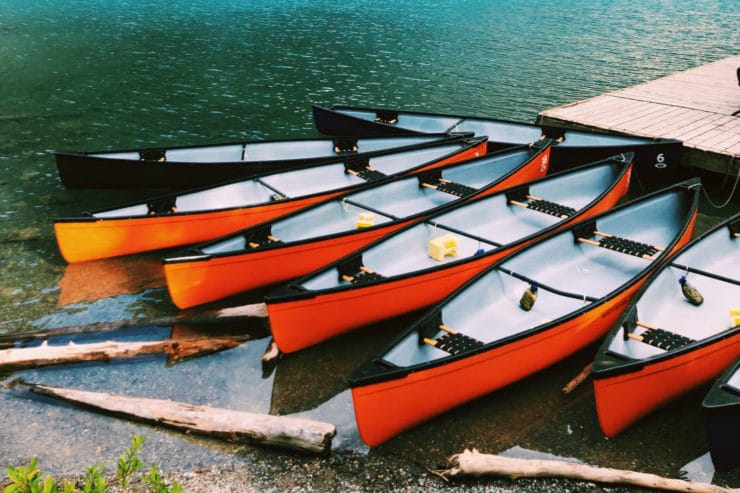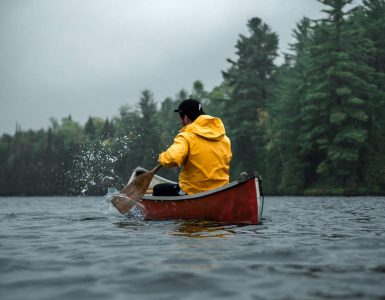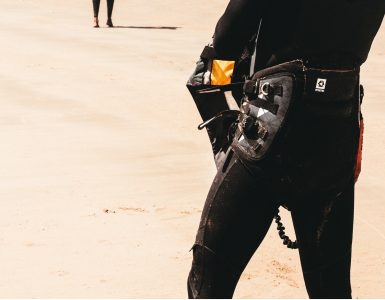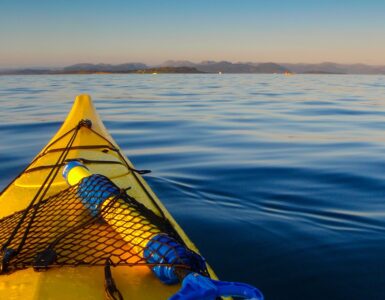Before buying a canoe, everyone should familiarize themselves with the most important features in order to avoid buying mistakes.
The best canoes reviewed:
In our Checklist, we show you which features are important when buying and how to recognize good quality. In our recommendations, we present the most popular canoes at 2024. These tips will help you find the best product quickly.
Contents:
The best canoes 2024 reviewed.
The following canoes have established themselves in the leisure sector and are extremely popular:
1. Best stable canoe
This canoe measures 368 x 86 cm and weighs around 15 kilograms. It is supplied with a carrying bag, pressure gauge, removable fin and repair kit. The outer shell is made of robust polyester.
- Robust
- Stable in the water
- Quick to set up
- Carrier bag tears out quickly
- Backrests offer little support
Why we like it: Its raised side walls give the boat the typical canoe shape and it sits securely on the water. The PVC base chamber and the side chambers have a web construction to increase stability and can be replaced if defective. The middle seat can be installed or removed as required.
Recommended for: The boat is suitable for 2 adults and 1 child and can therefore be used very well for family outings on the water. It can bear loads of up to 200 kilograms.
2. best canoe with high side walls
- Stabiles, aufblasbares Kajak für zwei Erwachsene in der klassischen Kanuform mit...
- 2er Kanu mit Boston Ventilen für einfaches Aufpumpen und Luftablassen
- Die zwei Kajak Sitze sind aufblasbar, einfach zu verstellen/herauszunehmen und bieten...
- Das kompakte Kanu hat eine robuste Polyester-Außenhülle mit abgeklebten Nähten,...
- Abmessungen Kajak aufgeblasen: 314 x 88 cm, Gewicht: 12 kg, Tragkraft: 165 kg;...
- Simple structure
- Easy to control
- Good workmanship
- Difficult to dry
- Rather small for 2 people
Why we like it: The robust and hard-wearing outer shell is made of PVC and promises high durability. Ergonomic carrying handles help when lowering it into the water and, like the practical bag, contribute to easy transportation. The seats can be easily removed or reinstalled to use the canoe as a single or two-seater. The boat is quickly assembled and ready for use within 10 minutes.
Recommended for: The canoe can be used as a single or two-seater and can be loaded with up to 165 kilograms.
3. best canoe for short distances
This canoe measures 296 x 84 cm when inflated, but weighs just 8.5 kilograms. It is supplied with a bag, pressure gauge and repair kit. Large valves allow the boat to be inflated and deflated quickly.
- Light
- Easy to transport
- Fast assembly
- Sags at weight close to load limit
- Boat is open at the back
- Drying takes a long time
Why we like it: With its low weight and the included carry bag, the canoe is easy to transport. It features comfortable seats with adjustable backrests, padded footrests and ergonomic, soft handles. A transparent bow window allows you to observe the underwater world beneath the boat. The different air chambers are independent of each other to increase safety in the event of a leak.
Recommended for: This canoe is suitable for two adults and a maximum load of 150 kilograms.
4. best canoe for 3 persons
This canoe is supplied as a complete set with foot pump, transport bag, paddle and two fins. It measures 375 x 108 x 52 cm and weighs 21 kilograms. The three seats are upholstered and offer sufficient space.
- Fast assembly
- Good customer service
- Price-performance ratio
- Level difficult to estimate
- A bit cramped for 3 adults
Why we like it: The canoe impresses with plenty of storage space and a luggage strap that ensures the safe transportation of equipment. It is inflated within a short time using the foot pump supplied. The two robust, free-standing fins keep the boat stable on the water
Recommended for: The canoe is suitable for up to 3 people with a maximum weight of 230 kilograms. It can be used at sea, on the river or on the coast.
5. best canoe for 1 person
When inflated, the canoe measures 274 x 76 x 38 cm. It weighs just under 11 kilograms and, with a pack size of 60 x 45 x 42 cm, can be easily transported in the bag supplied. It also comes with an air pump, paddle and repair kit.
- Inexpensive
- Good workmanship
- Quickly assembled
- Transport bag quickly becomes defective
- Not suitable for tall people
Why we like it: The reinforced floor supports the stable handling of the canoe. It is very agile and enables quick changes of direction. The hard-wearing vinyl material promises a long service life. It is resistant to salt water, oil, abrasion, pressure and UV radiation.
Recommended for: The kayak is suitable for one person and a maximum weight of 100 kilograms. However, it is somewhat uncomfortable for people over 1.70 meters, as the legs only fit in at an angle.
More articles you might find interesting:
Canoe Checklist: These features are important
- Type of canoe: Both inflatable and rigid canoes are commercially available:
- Inflatable models must first be inflated with a pump (electric or manual), while fixed models can be put directly into the water.
- On the other hand, inflatable canoes are much easier to transport and store. The technology is also more secure than ever before. Their performance, durability and portability make them the ideal companion for leisure time.
- Material: A wide variety of materials are used to make canoes:
- PE: Particularly robust and durable.
- Laminates made of GRP, Kevlar or carbon: Particularly light, but also less robust than PE.
- PVC: Very good price-performance ratio in the air canoe sector. As plasticizers evaporate over time, they can only be kept for about 10-15 years. PVC requires continuous maintenance.
- Ethylene propylene diene rubber (EPDM): Used for particularly high-quality air canoes. Withstands increased loads and high pressure. Decades of durability, but significantly more expensive than PVC.
- Wood: Traditional material. Long durability and great looks, but more sensitive than all other solid materials.
- Capacity: Before buying, think about how many people you want to take with you on the canoe and what weight capacity you need.
- Price: Good canoes quickly cost over a thousand $. If you are serious about canoeing, it is better to invest in a quality model from the outset. If you only want to do a little recreational canoeing, then a cheaper entry-level model will suffice.
Did you already know? The best kayaks 2024 can be found here.
Bestsellers: The most popular canoes on Amazon
(**Last update 2024-11-23)
FAQ: Frequently asked questions and answers
Content
- 1 Which canoe is best?
- 2 When can you start canoeing?
- 3 How expensive is a good canoe?
- 4 Is a canoe a boat?
- 5 What is a canoe?
- 6 What do you need for canoeing?
- 7 Which is better canoe or kayak?
- 8 What to wear when canoeing?
- 9 Which canoe is right for me?
- 10 Which canoe for beginners?
- 11 How many kilometers per hour can you cover in a canoe?
- 12 How many kilometers a day can you cover in a canoe?
- 13 How many kilograms can a canoe hold?
- 14 How much does a canoe weigh?
- 15 How many people fit in a canoe?
- 16 How long should a canoe be?
- 17 How fast can a canoe go?
- 18 How should you store a canoe?
- 19 How should you transport your canoe?
- 20 Like paddling a canoe?
- 21 Where can I buy canoes?
- 22 Where can you canoe?
- 23 What to look out for when buying a canoe?
- 24 Who invented the canoe?
- 25 Who sits where when canoeing?
- 26 Who steers the canoe?
- 27 Which muscles are trained when canoeing?
- 28 What is the alternative to canoes?
- 29 Is there a Consumer Reports or Öko Test on canoes?
Which canoe is best?
When can you start canoeing?
How expensive is a good canoe?
Is a canoe a boat?
What is a canoe?
What do you need for canoeing?
- Paddle: A paddle is used in a canoe and a double paddle in a kayak.
- Swim vest: Provides buoyancy in the event of capsizing and serves as impact protection.
- Weather-related clothing: In cold weather, neoprene or dry clothing is recommended. If it’s warm, swimwear and a T-shirt will suffice.
- Water shoes: Neoprene or similar. Water shoes are practical for avoiding wet feet.
- Water to drink: Canoeing is strenuous and you should always drink enough.
- Land and water maps: Where is the next mooring again?
- Sunscreen: Nobody likes sunburn.
Which is better canoe or kayak?
Canoeing is initially easier to learn than kayaking, as kayaking is more technically demanding. With increasing paddling experience, however, kayaking becomes much easier, as the power transfer to the forward movement is more effective than with a canoe.
What to wear when canoeing?
- Warm temperatures: Swimwear, sunscreen and a swim vest are all you need.
- Cold temperatures: Neoprene or dry suits are suitable for cold temperatures. In closed kayaks, wetsuit pants can also be combined with a dry jacket.
Which canoe is right for me?
- Kayaks
- Touring kayak: Suitable for tours on rivers or lakes.
- Folding kayaks: touring kayaks that can be folded to a small pack size.
- Inflatable kayaks: inflatable touring kayaks for easy transportation.
- Crossover kayak: A mixture of touring kayak and whitewater kayak.
- Whitewater kayaks:
- River-Runner: For navigating easy to moderately difficult white water.
- Creeker/ River-Runner: For navigating medium to very difficult white water.
- Freestyle kayak: For wave surfing.
- Sea kayak: For paddling on the open sea, in bays and in the surf.
- Fishing kayak: Kayaks especially suitable for fishing.
- Canadian
- Touring canoes: Open canoes for tours on rivers or lakes.
- Folding canoes: Open touring canoes that can be folded to a small pack size.
- Air canoes: Open touring canoes for inflating.
- Whitewater canoes: Open or closed canoes for easy to moderately difficult whitewater.
Almost all canoes are available in single or double versions. Canadians are also available for even more people. Canadians are usually open 4-person, 10-person canoes.
There are also a number of very special canoes for canoe racing, canoe polo or canoe slalom, for example.
Which canoe for beginners?
How many kilometers per hour can you cover in a canoe?
- Inflatable canoes can cover 3 – 5 km per hour.
- Touring canoes manage 10 – 12 km per hour.
- Racing kayaks can travel up to 20 km per hour.
How many kilometers a day can you cover in a canoe?
How many kilograms can a canoe hold?
How much does a canoe weigh?
How many people fit in a canoe?
How long should a canoe be?
How fast can a canoe go?
How should you store a canoe?
How should you transport your canoe?
- Boat dolly: A boat dolly is the first choice for transportation over short distances.
- Car roof: To transport one or more kayaks or a canoe on the car roof, crossbars and tension belts are required. Make sure that the weight of the boat does not exceed the maximum roof load of the car.
- Trailer: If you want to transport more, you can use special trailers, so-called boat trailers.
Like paddling a canoe?
A canoe is paddled with a paddle while kneeling or sitting and facing forwards. One person paddles only on the right or left side.
Where can I buy canoes?
Where can you canoe?
Always find out before a tour or excursion whether the desired body of water may be used. There are numerous navigation bans and waters with heavy shipping traffic. Violation of navigation regulations can result in severe fines.
What to look out for when buying a canoe?
- Intended use: When buying a kayak, you should consider from the outset what you need the boat for and then decide on the right type (see question: Which canoe is right for me?).
- Material: If you want a particularly light canoe, choose a laminated canoe made of GRP, Kevlar or carbon. If the canoe is to be robust, there is no way around PE.
Who invented the canoe?
Who sits where when canoeing?
Who steers the canoe?
Which muscles are trained when canoeing?
What is the alternative to canoes?
Is there a Consumer Reports or Öko Test on canoes?
*Price includes VAT, plus shipping. Customer reviews, prices, delivery times and costs may change in the meantime. By linking to selected online shops and partners, we may receive a small affiliate commission. There are no additional costs for you.

















Add comment